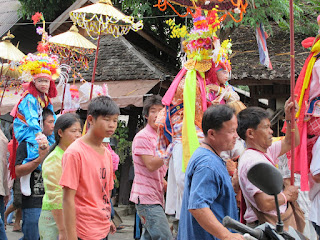What can I say about Songkran - how can I describe this festival to you?
The phrase I've read most often to describe Songkran - and Songkran in Chiang Mai in particular - is the world's biggest water fight. It is that - warring factions standing in bars on opposite sides of the street; roaming gangs with everything from THB800 (AU$26) mega water pistols to mini-mouse backpacks and miniature Winnie the Pooh squirters; trucks, tuk tuks and minibuses piled with people filling small buckets with ice water from a 40 gallon drum to hurl at people as they drive by (or sit stationary in traffic); and the most dangerous of all, people standing next to the khlongs (moats or canals), hauling up buckets of smelly brown water containing who-knows what visible and invisible nasties to hurl at you.
And while all of that is a lot of fun, especially when you're with a posse of like-minded water wielders - Songkran is so much more than just a three day water fight.
It's the national holiday for the people of Thailand. Wednesday, Thursday and Friday are public holidays, and people travel back home to be with family, or go away with friends, or simply take time off from work to relax and escape the usual working grind.
The equivalent holiday for us would be Christmas in the West - the excitement, anticipation, and participation. But it seems to have none of the commercial hype we so often bemoan in Australia. Apart from street vendors selling water pistols to willing visitors, there are no over-decorated, over-priced and over-hyped stores trying to sell you the latest and greatest of anything under the thin consumer veil of some greater holiday principle such as "the Spirit of Songkran".
Thai New Year is celebrated both as a religious communal holiday, and as personal
time out. The local wat (temple) plays a part in the Songkran activities, with parades, events, and individuals visits to receive blessings from the monks.
You could draw a parallel with Christmas here too, when every year we see at least one news story touting full church services as the once-a-year faithful return to their religious roots for a reminder of the Christmas message.
Songkran is inclusive. In Chiang Mai - famous as one of the best places to celebrate Songkran in Thailand - people come from all over the world to experience the way Thais celebrate New Year.
I met fellow Australians, Americans, Chinese, Israelis, French, Saudis, Japanese and of course Thais from the South, all converging on this place for three days of fun.
For the local people, family is a big part of Songkran. The first day is dedicated to respect for elders, when older people, monks and others are particiularly honoured. The next day is then family day, when families gather and re-unite for the new year.
It was heart-warming to see the number of kids - from toddlers to teens - standing with their parents, buckets, water-pistols and hoses in hand to join in the fun. Small children grappling with water pistols as big as themselves, or trying to lug small buckets of water high enough to get water further than their own feet were sights that always had you reaching for a camera, or willingly sacrificing yourself to their dousing efforts.
Unfortunately, Songkran is also a time when a lot people get hurt. This year, 29 people died in road fatalities on the first day of Songkran alone. The majority of these were due to drunk driving or speeding, and most involve motobikes. We witnessed one group of four people (three of them tourists) trying to get on to one moped and ride off stylishly down the street when they could hardly stand up themselves.
Luckily there were no serious injuries (though the moped hurtled off alone into a pole). Our offers of assistance were unwanted, but we did strongly suggest that maybe they should get a cab instead.
As I sat in my own cab this morning heading to the airport to leave Chiang Mai and Songkran behind me, I thought that this must also be a huge economic boon to this region.
For a town that reminds me of Cairns - regional, surrounded by farming districts, removed from the capital - the influx of local and overseas visitors must bring a goldmine of investment, spending, and international attention to their economy. Metropolitan Chiang Mai has a population of around 1 million people.
Consider the fact that of our group of eight friends who got together in Chiang Mai, six of us stayed longer than the festival, took small trips to surrounding towns for a few days either side of Songkran, purchased at least two meals per day outside of our hotels, went on tours, shopped, bought ancilliary festival items (such as water pistols, hats, water-proof wallet holders, sunscreen, water-proof cameras, etc), caught tuk tuks and cabs, tipped everyone from restaurant staff to elephant handlers, and had one or two drinks here and there, and you begin to get some small idea of the amount of money that must be spent in this regional city over the week of Songkran.
Predictions by the Tourism Authority of Thailand before Songkran said there'd be THB5 Billion spent across the country by tourists in 2011, and THB1.2 Billion of that in Chiang Mai.
But the beautiful thing about Songkran is that it hasn't become all about the money - at least not to my eyes. I'm sure there are those locals who plan and possibly even scheme up ways to separate tourists from their baht while they have them in Chiang Mai for three solid days of exchanging water - but it's not the focus, and I for one - khlong water aside - have certainly not walked away with a bad taste in my mouth.
Sawasdee pee mai, khup.
D.







No comments:
Post a Comment